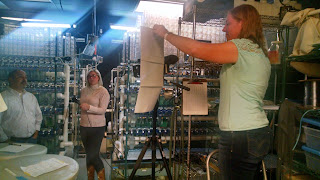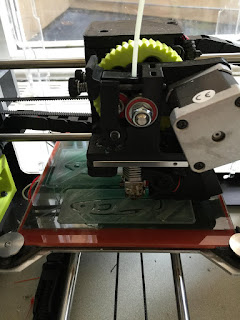 |
| Observing how predators preferentially chose guppies from certain environments (guess which ones?) |
I have been involved with a major outreach project to create self-guided kits for teaching evolution in K-12 classrooms. This project is a collaboration between me (as part of my broadening participation efforts on my NSF grant), Dale Broder (a senior graduate student whose work we are building off of), Dr. Cameron Ghalambor (who has helped Dale implement a similar program with local 7th grade classrooms), Dr. Lisa Angeloni (who has helped with several other similar outreach projects), and the CSU College of Natural Sciences Education and Outreach Center (yes, we have one of those!). The goal for these kits is three-fold: 1) to be able to expand our program beyond what we can reach ourselves (this is where the EOC comes in!), 2) to increase classroom engagement by using live animals, and 3) to use an authentic science approach to increase scientific self-efficacy (help students realize they CAN actually do science) and learn about evolution the same way scientists have done. We are particularly interested in implementing this program in schools that serve low-income and underrepresented students. To address potential psychological barriers these students may have (which they may not even realize), we have made a significant effort to include scientists representing several aspects of diversity, both in an introductory video the students will watch prior to starting the activity, as well as with an interview included in the final pages of the instruction booklet. These kits will be directed toward middle and high school students initially, but could also be adapted for other age or ability levels as well.
Follow along here as I post updates on how these kits are coming along!
UPDATE 9/17/15
Well, as far as an update goes, this is a little late as we have made significant progress on the kits since we first met with the EOC back in May. We have also submitted an abstract for a poster at the upcoming Society for Integrative and Comparative Biology meeting in Portland, OR (see my previous post).
The activities for the kits include:
1) Observe the variation in physical differences between males from three populations of guppies (pet store, wild low predation, wild high predation).
2) Understand how color patterns are passed on between parents and offspring using punnett squares.
3) Observe guppy predator avoidance behaviors and quantify survival when exposed to predators (this will be done using pre-recorded high-speed videos).
4) A thought exercise to address how color patterns change over time due to various types of selection.
In the last few weeks, Dale and I have figured out how to assemble small acrylic tanks that don't leak (not a minor task). These will be used as small observation tanks.
 |
| Dale gluing a tank |
 |
| The finished product! |
We have also been working hard on assembling the introductory video, with the help of a local videographer. This included recording an interview with each of our scientists using some local news crew equipment that Dale borrowed.
 |
| Interviewing Cameron in the breeding lab |
If that wasn't enough, we recruited an undergrad, Ty Fiero, to help with 3D printing some guppy stencils, so the students can draw a fish that they can then add fins to and color in.
 |
| Yes, those are glow-in-the-dark! I drew them myself! |
We have also been working closely with Andrew Warnock, from the EOC, to compile the instruction booklet that the students will use. This included coming up with a name for our kits.
It's coming together! Our goal is to be finished in time for a teacher workshop in October.
UPDATE 09/18/15
We now have predator silhouettes for students to test how each guppy might respond to predators. They will then make predictions about what they think will happen with real predators. I made a range of sizes to figure out which one works best.
UPDATE 10/29/15
So we didn't make our October deadline...
We ran into some hurdles with IACUC approval as well as trying to figure out better options for the observation tanks. We've decided to change the teacher workshop to January, which will actually work out better for when they will teach evolution in their classes. Plus it gives us a little more time to make everything just right.
Today we were finally approved to move fish to the Education and Outreach Center! We had to set up the tanks first without fish so they could inspect the room. Now that we're approved, I added some living things today - some nerite snails and some aquatic plants, Vallisneria and Ludwigia. Next comes guppies...
 |
| 20g tank for petstore guppies |
 |
| 10g tanks for wild guppies |
UPDATE 12/10/15
We're making the final push for our guppy kits! Dale and I have put a lot of work into the instruction booklet, and just wrote the final pages outlining the 4 components of Evolution the students worked through (Variation, Inheritance, Selection, and Time). We also provided some FAQs in case students have more questions about the projects they do.
We also finalized our introductory video that the students will watch before they start. This will be used to introduce the guppy system and let them hear from real scientists.
We encountered a hurdle recently regarding the observation tanks in the kits - do we ask the students to observe one guppy at a time and rotate, or do we ask the students to observe multiple guppies at a time, and if so, how do we facilitate that? Since variation is an integral concept for students to understand, we decided we wanted the later option, so then the question became do we put multiple fish in one tank or do we include multiple tanks. One of our collaborators had the idea to make nesting tanks, so we gave that a shot! They turned out well, so I think this is what we will go with.
 |
| Two nested observation tanks |
 |
| 3D printing guppy stencils (Photo by Ty Fiero) |
Here are the completed stencils, and what the traces look like:
 |
| The guppy stencil finished product! |
The last piece of this puzzle that I have been working on is the poster that I will present at SICB this January. Dale and I will be co-presenting our poster (abstract #P1-7) on
Monday Jan. 4 from 3:30pm-5:30pm in Exhibit Hall A
Thursday Jan. 7 at 9am in room B115
UPDATE 12/18/15
The first full draft of the instruction booklets have been printed!
 |
| Andrew did the illustrations! |
 |
| It looks like a kit now! |
 |
| Everything fits inside! |
AND...the poster is finished! SICB 2016: ready or not, here we come!
 |
| Well I guess you'll just have to come see our poster! |
Updates have been moved to a permanent page, which can be accessed here: http://emilyakane.blogspot.com/p/guppy-kits.html



